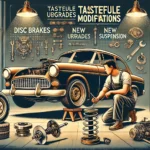Proper winter storage is essential to protect your classic car from harsh weather, moisture, and long periods of inactivity. Without the right precautions, cold temperatures and humidity can cause rust, battery drain, and engine damage. Follow this step-by-step guide to ensure your vintage vehicle remains in top condition throughout the winter months.
1. Clean and Prep the Car Before Storage
Before parking your classic car for the winter, a thorough cleaning helps prevent damage.
🧼 Exterior Cleaning:
✔ Wash and dry the car completely to remove dirt, salt, and debris.
✔ Apply a high-quality wax to protect the paint from moisture.
🛠 Interior Cleaning:
✔ Vacuum carpets and wipe down surfaces to prevent mold and odors.
✔ Use a leather or vinyl conditioner to prevent cracking in cold temperatures.
Pro Tip: Place moisture-absorbing packets inside the car to prevent mold and mildew.
2. Change Fluids and Top Off the Tank
Fluids degrade over time, so fresh fluids will help prevent corrosion and engine wear.
🛢 What to Change or Refill:
✔ Oil & Filter: Old oil contains contaminants that can harm the engine.
✔ Coolant: Ensure it has the proper antifreeze mix to prevent freezing.
✔ Brake Fluid: Replace if it’s more than two years old to prevent moisture buildup.
✔ Fuel: Fill the tank to prevent condensation, and add a fuel stabilizer to keep the fuel fresh.
Pro Tip: After adding stabilizer, run the engine for a few minutes to circulate the treated fuel.
3. Protect the Battery
Cold weather can drain the battery, so take steps to keep it charged.
🔋 Battery Storage Tips:
✔ Use a battery maintainer (trickle charger) to prevent discharge.
✔ If storing the car for months, disconnect the battery or remove it completely.
✔ Store the battery in a dry, warm place if removing it from the car.
Pro Tip: Clean the battery terminals and apply anti-corrosion grease before storage.
4. Prevent Flat Spots on Tires
Tires can develop flat spots when a car sits in one place for too long.
🛞 Tire Protection Tips:
✔ Inflate the tires to the recommended pressure or slightly higher.
✔ Place the car on jack stands to take weight off the tires and suspension.
✔ If jack stands aren’t an option, roll the car slightly every few weeks to shift the pressure points.
Pro Tip: Use tire cradles or foam pads for added protection if leaving the car on the ground.
5. Store the Car in a Dry, Climate-Controlled Space
A controlled environment will protect your car from temperature fluctuations and moisture damage.
🏠 Best Storage Locations:
✔ Heated Garage: The ideal place for winter storage.
✔ Unheated Garage: Use a dehumidifier or moisture absorbers to control humidity.
✔ Car Storage Facility: Choose a reputable location specializing in classic car storage.
🚫 Avoid: Parking the car outside or in a poorly ventilated shed, as exposure to the elements increases the risk of rust and damage.
Pro Tip: If the garage isn’t climate-controlled, place a tarp or plastic sheeting under the car to prevent moisture from seeping up from the floor.
6. Cover the Car Properly
Using the right car cover is essential for protection.
✔ Use a breathable, high-quality car cover that prevents moisture buildup.
✔ Avoid plastic tarps, as they can trap condensation and cause rust.
✔ If storing in a dusty area, cover the car with a second soft cloth sheet for added protection.
Pro Tip: For extra security, place steel wool in the exhaust pipes and air intake to prevent rodents from nesting inside.
7. Avoid Starting the Car During Storage
Some believe starting the engine periodically prevents issues, but doing so without driving the car can actually cause condensation buildup.
🚗 When to Start the Engine:
✔ If you plan to start it, make sure to run it until the engine reaches full operating temperature.
✔ Drive it for at least 15–20 minutes to circulate fluids properly.
🚫 Avoid: Short engine startups that only last a few minutes—they do more harm than good.
Pro Tip: If you don’t plan to drive it at all, it’s best to leave the car undisturbed until spring.
8. Check on the Car Periodically
Even in storage, occasional check-ins can prevent surprises in the spring.
📅 Monthly Check-Ups:
✔ Inspect for leaks or signs of rodents.
✔ Ensure the car cover remains secure.
✔ Recharge or check the battery if not using a trickle charger.
Pro Tip: Open a window slightly to allow airflow and prevent musty odors.
9. Preparing the Car for Spring Driving
When winter is over, follow these steps before taking your car out on the road:
✔ Remove the car cover carefully and inspect for any dust or moisture.
✔ Reconnect the battery (if removed) and check the charge.
✔ Check tire pressure and adjust as needed.
✔ Inspect fluids, belts, and hoses for any leaks or cracks.
✔ Wash and wax the car to remove any storage dust before the first drive.
Pro Tip: Take the car for a short drive at low speeds to ensure everything is running smoothly before going on longer trips.
Final Thoughts
Proper winter storage ensures your classic car remains in excellent condition, ready to hit the road when the weather warms up. By following these steps, you’ll prevent costly damage and keep your vehicle preserved for years to come.








